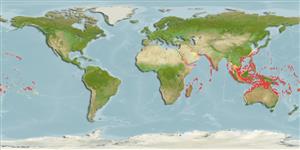>
Acanthuriformes (Surgeonfishes) >
Acanthuridae (Surgeonfishes, tangs, unicornfishes) > Acanthurinae
Etymology: Zebrasoma: Derived from Zebra = African horse + Greek, soma = body; referring to the stripes (Ref. 45335).
More on author: Cuvier.
Environment: milieu / climate zone / depth range / distribution range
Ekologi
marina revassocierade; djupintervall 0 - 60 m (Ref. 1602), usually 1 - 60 m (Ref. 27115). Tropical; 25°C - 28°C (Ref. 27115); 31°N - 34°S, 32°E - 124°W
Indo-Pacific: East Africa, including the Mascarene Islands (Ref. 37792) to the Tuamoto Islands, north to southern Japan, south to Lord Howe and Rapa islands.
Size / Vikt / Age
Maturity: Lm ? range ? - ? cm
Max length : 40.0 cm SL hane/ej könsbestämd; (Ref. 48637)
Taggstrålar i ryggfenan (totalt): 4 - 5; Mjukstrålar i ryggfenan (totalt): 23-25; Taggstrålar i analfenan 3; Mjukstrålar i analfenan: 19 - 21. Dark brown (body in life with fine pale blue-green longitudinal lines following scale rows, becoming dots anteriorly on body and on head) (Ref 9808). Small juveniles have yellowish bars and more prominent yellow specks than adults.
Occurs in coral-rich areas of lagoon and seaward reefs. Graze on algae, usually in groups of 20 individuals (Ref. 5503, 48637). Adults usually in small groups and sometimes schooling. Juveniles solitary and usually among corals (Ref. 48637). Its numerous, small pharyngeal teeth may have evolved in response to a shift in diet from macroalgae to filamentous algae (Ref. 33204). Form resident spawning aggregations (Ref. 27825). Monogamous (Ref. 52884). Group and pair spawning have been observed. The flesh is never poisonous (Ref. 4795). Minimum depth reported taken from Ref. 128797.
Life cycle and mating behavior
Könsmognad | Reproduktion | Lek | Ägg | Fecundity | Larver
Form resident spawning aggregations (Ref. 27825). Monogamous mating is observed as both facultative and social (Ref. 52884).
Myers, R.F., 1991. Micronesian reef fishes. Second Ed. Coral Graphics, Barrigada, Guam. 298 p. (Ref. 1602)
IUCN Red List Status (Ref. 130435)
Threat to humans
Harmless
Human uses
Warning: mysqli::__construct(): (HY000/1040): Too many connections in /var/www/html/includes/func_getlabel.php on line 46
Can't connect to MySQL database (fbapp). Errorcode: Too many connections
